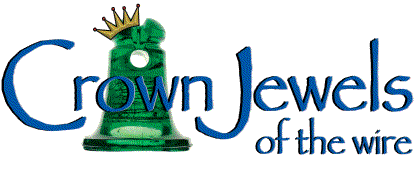Lightning Rod Insulators
by Howard Banks
Reprinted from "Crown Jewels of the Wire", December 2003, page 38
Lightning rod insulators represent a fast growing area of insulator
collecting, with auction prices reflecting the surge in interest.
These little
globs of glass (see color pictures on pages 39 & 40) are gaining popularity
in the hobby due to their attractive colors and shapes, as well as their
history.
Lightning rod insulators (LRI's) are just that... glass objects that
insulated lightning rods and grounding cables from the buildings they were
mounted on. Some have large diameter holes through them so they fit over
lightning rods, insulating the rods from the roof mounting brackets. Other
styles had "slash" or "cross" tops. These were mounted along
walls to insulate the grounding cable from the building, and were affixed to the
building by metal brackets. Some had small diameter holes through them for the
tie wire, and others used a wire groove for that purpose.
In a web site¹, Roger
Russell lists 329 patents that were awarded for lightning rods and their
components starting in 1850. Lightning rods became big business by the 1860's,
with salesmen finding ready customers in the midwest and eastern US who were
willing to buy products to protect their homes and businesses from the real or
imagined dangers of lightning. Drive through rural communities yet today and you
still see thousands of lightning rod systems in use. Out west, where the threat
of lightning isn't as great overall, lightning rod systems were never as
popular.
The lightning rod insulators on the following two pages are from Todd
Grueninger's collection, and were photographed at the National Insulator Association's
annual convention last summer in Springfield, Ohio. They
demonstrate the wide array of colors that can be found in these jewels. Sapphire blue is a tough color in an LRI according to Todd, as he demonstrates
in his "slash top" pictured in the upper left on the next page. The
amethyst example shows the depth of color that can be found in some; and the
mustard colored examples in the middle row represent another tough color.
The
emerald green LRI at the lower left is embossed Hickcok's Patent. The insulator
has a slotted interior designed to fit a lightning rod invented by Russel Hickok
of New York on March 29, 1859. In his patent description, Hickok wrote that his
insulator design was improved over others because it was "a lightning rod
insulator made in one piece, so as to support and insulate the rod, and also
leave open spaces for water to pass through it, and for air, when suddenly
expanded, to escape from within it."² Some sources suggest Hickok's glass
insulators were manufactured by Canadian Glass Works.
Other names embossed on
LRI's include Spratt and Weston. Some items are believed to have been made by
Hemingray.
Collector Jim Colburn reports in another web site³ the he knows of
130 or more glass LRI shapes, and maybe twenty to thirty porcelain shapes. He
lists known colors in dear, straw, peach, grey, SCA, purple, royal purple,
milkglass, green, olive, jade, yellow-green, olive blackglass, emerald
green, lime, cornflower blue, cobalt blue, fight cobalt, teal, ink, rootbeer
amber, honey amber, blackglass, greenish amber, ginger ale, puce and more. The
most common, as in other insulators, is aqua.
In a "Pole Top
Discoveries" auction this fall, a dark emerald teal green Hickock's Patent
opened at $25, but sold for $121. An unmarked amber LRI of the same style as the
purple one on the opposite page opened at $150 and sold for $242. And a tall
"slash top" style in medium green opened at $120 and closed at $467. The
success of such auctions leaves no doubt that LRI's have "arrived" as
collectibles.
LIGHTNING ROD INSULATORS


Shown on the opposite page are additional lightning rod insulators in
desirable, but not as bright, colors. Todd Grueninger says that when he finds LRI's, they are often still attached to buildings and painted over with many
layers of paint. It's often not obvious what color the insulator is going to
turn out to be.
The insulator at the bottom right of page 40 is a CD 132.4
Hemingray product embossed Patent / Dec. 19 1871. Even though it is a lightning
rod insulator, it's listed in McDougald's price guide because it is a pin style
insulator. That is, it has screw threads and fastened on a pin like a telegraph
insulator. CD 132.4's were used in conjunction with CD 317's. The Chambers
company used these much larger insulators for their special brand of lightning
protection.
After attending the first national insulator show in New Castle,
Indiana in 1970, I visited my brother, Tom, in Brookville, Indiana. Tom lived in
a home that had been ordered out of a 1923 Sears catalog. But he lamented that
his home was the only one in the neighborhood lacking a lightning rod system. So,
my buddy Chuck Fox and I gathered up some Mickey Mouse insulators, some
lightning rods off homes abandoned during the construction of a new reservoir,
and fashioned a Chambers-style system. I returned to the home for the first time
in 30 years this past summer, and was delighted to find our own version of the
Chamber's system still in use.



Our version of a wall mounted LRI was rather
large. In this case, a CD 252 Hemingray. Notice that it is now splattered with
paint. The year after we installed the lightning rod system, lightning struck
the home. My brother, Tom, said he immediately ran out of the house and grabbed
the ground cable to see if it was hot. He reported it was cool, convincing him
that the system protected his house from damage. But I've always marveled at the
fact that the home went almost 50 years without being struck by lightning, and
then was struck shortly after a lightning rod system was installed!
References:
1. http://home.earthlink.net/~rogerr7 /lightning2.htm
2. http://www.nia.org/timeline/text/0023373.htm
3. http://www.insulators.com/go-withs/lri.htm
|
